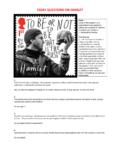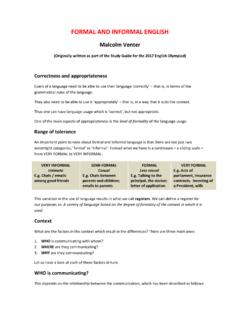Transcription of POETRY NOTES: Grade 12 Noelin Naidoo, HOD: Alexandra …
1 POETRY NOTES: Grade 12 noelin naidoo , HOD: Alexandra High School INDEX: Introduction to POETRY Tone words 1. The Garden of Love (p 159) p13-18 2. Felix Randal (p 112) p18-21 3. somewhere i never travelled, gladly beyond (p 25) p22-26 4. A Hard Frost(p 139) p26-29 5. Funeral Blues (p 122) p29-35 6. An African Thunderstorm (p 155) p36-40 7. Vultures (p 48) p40-44 8. An African Elegy (p 45) p 44-47 9. The Zulu Girl (p 56) p 47-52 10.
2 Motho ke motho ka batho babang (p 56) p 52-54 11. First Day after the War (p 32) p 54-56 12. Remember (p 5) p 56-60 Grade 12 POETRY Notes Page 2 Terms you must be familiar with: Theme Intention Style Diction Tone Mood Form Rhythm Rhyme Imagery Symbolism Theme: It is the subject, central idea or underlying thought. It is sometimes also equated with the meaning or sense of piece of writing. Intention: The reason or motive the poet had for writing his poem. The poet may want: * to persuade * to defend, * to express hatred / scorn * to protest, * to praise, * to argue, * to express love, * to flatter, * to warn, * to criticise, * to evoke sympathy, * to enrage, * to mock, * to incite, etc.
3 Style: It is the manner in which a poet or writer expresses himself, his distinctive traits or the individual manner in which he uses the language at his disposal. It includes many aspects but sometimes it helps to look at the period in which the poem or work was written to determine the poet s style. Sometimes it is useful to sum up a poet s style in a word or two: * colloquial, * conversational, * emotive, * factual, * humorous, * idiomatic, * sensational, * succinct, * terse, * technical, * clich d, etc. Diction: This refers to the poet s vocabulary or choice of words. The choice of words and the order thereof, is intention to suit the poet s purpose. Remember that words do not always have a fixed meaning: their exact meaning depends of their context. The sound of words may be important as well.
4 Every word used by poet must be seen as a way to enhance his intention. Tone: It is the poet s attitude towards his subject and towards his readers. The tone can only be determined once one has examined the poem thoroughly. The tone may also vary within a poem. Examples of tone: * sincere, * humorous, * forceful, *critical, * sarcastic, * ironical, * loving, * sentimental, * joyful, * melancholy, * bitter, * mocking, etc. INTRODUCTION TO POETRY Grade 12 POETRY Notes Page 3 Mood: Mood or feeling is a term used to refer to the atmosphere the poet creates within his particular work. It is related to the tone and in some ways mood may also be said to reflect the poet s attitude towards his subject matter. FORM: or structure and it may be rigid and prescribed or loose and undefined.
5 BALLAD: Most ballads started as songs passed on from one generation to the next. Characteristics: * fast moving story, * rhythm is pronounced * rhyme pattern (usually rhyming couplets or alternate rhymes) and * metre is usually iambic. Poems in short stanzas narrating popular story without rhyme pattern or unpronounced rhythm, is narrative POETRY . Entertains the readers by telling a dramatic story. METRE: Poetic rhythm determined by character and number of feet. IAMBIC: unstressed syllable followed by a stressed syllable. TROCHIAC: stressed syllable followed by an unstressed syllable. ODE: Poem often in the form of an address and in exalted style, in praise of something/one. It is exalted in both feelings and expression, written in rhymed stanzas.
6 Expresses the speaker s admiration. ELEGY: Song of lamentation or morning that honours someone /thing that has died. Subject matter is treated in a suitable serious fashion. The tone is sad and mournful with a slow rhythm. Expresses the speaker s sorrow. LYRIC POETRY : Originates also in songs. It is much more emotive that usually conveys feelings. It is typically a short poem that deals with a single theme or idea. Expresses the speaker s feelings. AN ALLEGORY It is the representation of abstract ideas or principles by characters. Once again the allegory makes use of the story form, and it is long, but it either has a religious theme or it contains a moral warning, or offers advice to the reader, Animal Farm Rhythm: Rhythm is the follow of words or beat in a poem.
7 It is the repetition or recurrence of stress. Metre is the term used to describe the measurement of regular rhythm. Grade 12 POETRY Notes Page 4 The function of rhythm is to emphasise or endorse the meaning of the words in a poem. It can also help create a particular mood or atmosphere, convey a particular theme or set a particular pace. Rhyme: It is the repetition of similar sounds. a) End rhyme: rhyme occurs at the end of lines of verse. (time; crime) b) Half rhyme: words do not fully rhyme but there is a similarity in sound. (work; pitchfork) c) Internal rhyme: a word in the middle of the verse line, rhymes with the word at the end of the verse line. ( In mist or cloud, on mast or shroud,) Imagery: It is the use of word pictures or images that usually appeal to our senses but they may also appeal to the heart or the mind.
8 Figures of speech: Words, phrases or expressions used in a manner other than their literal meaning in order to produce a special effect. It is important to know how figures of speech work. POETIC DEVICES & FIGURES OF SPEECH FUNCTION / EFFECT ( ) Figures of speech based on associated ideas METONYMY: Substitution of the name of something for that of the thing meant, And ploughs down palaces, and thrones, and towers. It may serve to emphasize a certain aspect of the person or object concerned. SYNECDOCHE: A part is named but the whole is meant/ understood, OR the whole is named but only part is meant/understood, .. his back to the five thin healthy head grazing. It may serve to emphasize the aspect which is selected, but often it is just a case of common usage.
9 HYPERBOLE: Exaggerated statement. Not meant to be taken literally, It expresses intense emotion and emphasizes the fact stated. LITOTES: Ironical understatement, esp. expressing an affirmative by the negative of its contrary. It emphasizes the statement. EUPHEMISM: Substitution of vague or mild expression for harsh or direct one, He passed away is a euphemism for He died . Grade 12 POETRY Notes Page 5 Other useful terminology RHETORICAL QUESTION: Asked not for information but to produce effect. It emphasizes the fact stated. It draws attention to the statement and makes the reader stop and think. APOSTROPHE: The poet addresses an inanimate object, or an absent person. It creates a sense of immediacy; it makes the person or object addressed seem closer and more real.
10 When an inanimate object is addressed it is, of course, personified. PATHOS: Quality in writing that excites pity or sadness. Excites pity or sadness. ENJAMBMENT: Continuation of sentence beyond end of line, His state Is kingly; thousands at his bidding speed And post o er land and ocean without rest: It suggests continuation, so strengthens the meaning of lines which state that something is going on without stopping; it creates a fluent movement or helps create a restful mood; Sometimes it emphasizes the last word of one line and the first word of the next line if the end of the first line occurs at an unusual position. INVERSION: Reversal of normal, grammatical order of words, How with this rage shall beauty hold a plea Whose action is no stronger than a flower.









